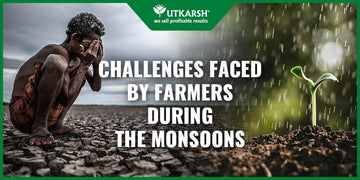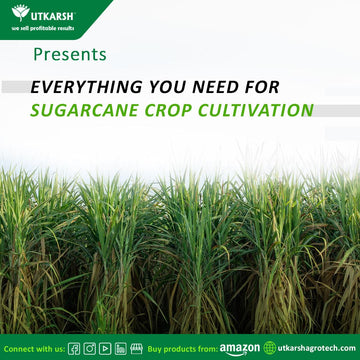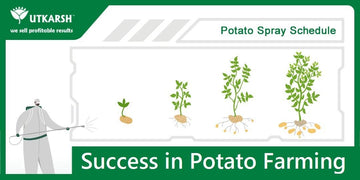
Yes! We are talking aboutchallengesfaced by farmers during the monsoons! What a paradox! Monsoon is one of the most important seasons for farmers in India which is so dependent on its agro-industry: farming. Most of the agricultural land in India gets the water supply for irrigation from the rains during the monsoon season (southwest monsoon rains) & crops that form the staple Indian diets such as wheat, rice, and pulses, need heavy rainfalls to grow. So how can monsoon be a challenge to farming???!! Isn’t it a boon? Actually, it would be more apt to say that the real challenge is the disappearing act of water after the monsoons have ended.
Global warming has complicated matters further and brought about a different challenge. Droughts and lack of water were already a challenge but now the additional challenge of floods is also complicating the issue further…. It’s like 2 ends of a single spectrum- too less water or too much water affecting Indian farmers during the monsoons.
“The overall Indian economy remains very vulnerable to the monsoon since poor rainfall can significantly reduce agricultural production.” – Rajiv Biswas
For proper growth of crops anywhere in the world, water is an essential element. Its shortage can make the farming process come to a complete standstill. The best way to assure sufficient water for farming is through a collection of rainwater during the monsoon season. Through the ages, rainwater harvesting or the collection of rainwater from impervious surfaces/roof structures, has been the sure-fire way of attaining water self-sufficiency. The collected water helps to deal with a significant part of the farming water needs throughout the year.
Indian history has always been lauded for its agricultural efficiency, excellent climatic conditions, and natural-resource availability. Though the cultivation of wheat, rice, and cotton is the major trend among farmers, India is a leading producer of spices, pulses, and milk in the international market. Some time back, the agriculture sector contributed to about 75% of India’s GDP, though it has now reduced to a mere 14%. Therefore, India is considered to be an influential, global, agricultural hub with farming as its backbone.
Like many other sectors in any developing country, the agricultural landscape also faces decades-long problems and unexpected challenges that are crucial to rectify. To name a few of the challenges farmers face in India:
- Poor irrigation facilities shortage or over-abundance of water supply.
- Lack of awareness of modern farming technology & equipment.
- Lack of modernization of farming equipment.
- Traditional crops’ farming rather than the farming of crops that are in demand.
- Decrease of soil fertility due to over-fertilization and sustained pesticide use
- Soil erosion by both wind and water
- Fragmentation of land holdings.
- Unavailability of good quality Seeds.
- Lack of Storage facilities.
- Lack of awareness &/or access to transparent, index-based crop insurance.
- Lack of awareness of supportive government schemes.
- Lack of agricultural marketing
- Farmers have to deal with local traders & middleman reducing their income
- Lack of remunerative income & debt burden on most farmers.
- Capital Scarcity and Low purchasing power
- Lack of allied infrastructure: poor storage facilities, transportation problems, market access.
- No R&D is related to farming, seeds, fertilizers, etc.
However, the most marked challenge for farming, during MONSOONS continues to remain the uncertainty of consistent water supply; and it takes on a very big significance in the farming scenario in India, especially when the monsoon is around the corner. An in-depth analysis of this uncertainty also reveals possible solutions which need to be discussed and highlighted.
Uncertainty of water supply/ shortage of water supply in monsoon:
In the last decade, unfortunately, the percentage of irrigated agricultural land in India has reduced considerably. Now, the majority of the Indians involved in farming are completely dependent on the monsoon water for irrigation of their crops. Farming has thus become risky because of the uncertainty of water availability for agriculture. Though the statistics show that the total rainfall in our country is satisfactory, its distribution across India is however highly erratic. The variation of rainfall not just in a particular region but across different regions has become uncertain. Thus, insufficient water supply or lack of stored water available, in case monsoons have been poor is one of the major challenges faced by the common Indian farmer.
TheRevised Draft National Policy for Farmers, popularly known as the Swaminathan reporthas clearly stated thatjal swaraj,or self-sufficiency in irrigation water availability is the need of the hour. The majority of our farmers depend on groundwater for irrigating their crops, an increasingly depleted resource, in which most farmers have invested their hard-earned savings, Therefore, rainwater harvesting and aquifer recharge have become essential for ensuring stability of supply.
Rainwater harvesting in monsoon:
Today, a dearth of usable water has become the main topic of concern in farming. However, pure, uncontaminated, good quality rainwater, that can be used for irrigation, washing, cleaning, bathing, cooking, and also for other livestock can be stored or harvested. Through the ages, our ancestors have been practicing a simple process of accumulation and storage of rainwater for reuse rather than allowing it to run off. This is called rainwater harvesting. It is a sustainable process of preserving water for future use long after the monsoon season is over. Rooftop rainwater harvesting and surface runoff harvesting are a few examples to cite.
Aquifer Recharge:
This is an important groundwater technology. Aquifer recharge (AR) is defined as the replenishment or recharge of water by human activities to the ground or an aquifer (A geologic unit that is highly permeable and can store and transmit a significant amount of groundwater called an aquifer.) with a specific intent to replenish groundwater. Thus, an aquifer is an underground layer of water-bearing permeable rock, rock fractures, or unconsolidated materials (gravel, sand, or silt). Unlike natural groundwater, the groundwater from aquifers can be extracted easily by using pre-configured water well. Both, AR and ASR (aquifer storage and recovery) replenish groundwater stored in aquifers for beneficial purposes like regular water supply for irrigation in farming, etc.
AR may occur naturally by the percolation (seeping) of surface water, precipitation, or the melted snow from the ground surface to a depth where the earth materials are already saturated with water.
AR can be “recharged” artificially by replenishing it with surface water (e.g. reuse of water, wastewater, flood water, or stormwater) or by forcibly injecting water into the underground environment (e.g. drain fields and dry wells).
Both, Aquifer recharge (AR) and aquifer storage and recovery (ASR) are artificially enhanced processes to convey water underground. They are often used interchangeably but are essentially separate processes with distinct objectives. Whereas AR is used solely to refill water in aquifers, ASR is used to actually store water so that it can be recovered later for use in industries or for farming. There’s an additional term, managed aquifer recharge (MAR) which essentially means the purposeful recharge of water to aquifers, by commercially inclined individuals or companies for subsequent recovery for commercial purposes.
(And to a little extent for environmental benefits as well) One can say it is a means to make water supply more consistent & resilient, helping balance out the seasonal and periodic decreases in water availability with increasing demands not only during but even after the monsoon that Indian farmers face today. With urbanization, we have gotten very good at pumping the water out of our underground reservoirs, or aquifers but now, to meet the challenges our farmers are facing, this well-developed groundwater technology, has become increasingly important to enhance our abilities to increase the recharging of groundwater for the water security of our farmers.
MAR comes in a variety of different forms from large-scale projects with hundreds of acres of infiltration ponds…to fields of aquifer storage and/or recovery wells…to flooding permanent crops seasonally…to low-impact development including permeable pavement, rain gardens, rooftop rainfall capture and recharge, and slow-it-spread-it-sink-it landscaping techniques.
Floods in monsoon and over-abundant water supply earlier than expected or too late:
Paradoxically, farmers are often challenged not just by a dearth of water for irrigation but also by floods or an over-abundance of water. Flooding can ruin fields and destroy crops by causing erosion and soil displacement. This erosion basically washes the fertile topsoil away which can leave crop plants with nowhere to set roots. Even, the sand, gravel, and rocks that are carried by the heavy deluge of water that accompanies flooding & is then deposited by the flood waters in the fields, have the tendency to smother and destroy exposed crops that are already growing there.
Flooding in key agricultural production areas can lead to widespread damage to crops, fencing, and loss of livestock. This affects the farming community just as much as a famine does. As if the crop losses through rain damage, soils that are waterlogged, and delayed harvesting are not enough, all these problems are further compounded by transportation problems caused by flooded roads and other damaged infrastructures like fallen trees and electric poles.
In conclusion, it’s safe to agree with farming experts who say that solutions are there; they just need to be embraced by Indian farmers. If the assured supply of water is delivered, to begin with, then solutions to all the other challenges are easily met; -ordinary seeds can be replaced with better varieties; similarly, instead of wheat and rice, more farmers can switch to other crops, like oilseed farming. We can then stop importing cooking oil from abroad despite having a suitable climate for growing such cash crops.
As a farmer, if you are facing any issue related to seed selection, irrigation, water quantity, equipment or pesticide usage, and anything related to farming/cultivation, etc., feel free to visit our Utkarsh website, and ask your questions, and get your queries resolved. We don’t just sell agro products; we believe in supporting our farmers and arming them from A to Z with all possible solutions to the challenges they face not only during the monsoon period but even after it is over.
उत्कर्ष के संग आपकी हर फसल होगी सफल।
Available on UtkarshAgro.com | Amazon | Flipkart | AgriBegri | Bighaat | Moglix | Agrosiaa | Toolsvila | Agri junction | Krishisuvidha | Ecotika | Shopee | Bazzu.in
Visit Website: https://utkarshagro.com/
You can also Shop from: https://www.badikheti.com/utkarsh
𝐂𝐎𝐃 𝐚𝐧𝐝 𝐄𝐌𝐈 𝐨𝐩𝐭𝐢𝐨𝐧𝐬 𝐚𝐫𝐞 𝐧𝐨𝐰 𝐚𝐯𝐚𝐢𝐥𝐚𝐛𝐥𝐞.
May you have the best yield ever! Feel free to contact Utkarsh for any doubts and advice.
If you have any further queries, feel free to reach out to us on
Call: 8866543678 or chat: http://wa.me/918866543678
Call: 9924864422 or chat: http://wa.me/919924864422
Call: 9664961571 or chat: http://wa.me/919664961571
Landline: 02621-255972
Visit our website: https://utkarshagro.com/
Email ID: rd@utkarshagro.com
Stay connected with us to learn more tips and tricks. All you have to do is follow us here:
Facebook: https://www.facebook.com/utkarshagrochem/
Instagram: https://www.instagram.com/utkarshagrochem/
YouTube: https://www.youtube.com/c/UtkarshAgrochem
Twitter: https://twitter.com/UAgrochem
LinkedIn: https://www.linkedin.com/company/utkarsh-agrochem-pvt-ltd/
Pinterest: https://in.pinterest.com/utkarshagrochemsocial/
Written by:
Dr. Shachi S. Patel
Affiliate Writer with Monkey Ads








